Alright, fellow anglers! If you’ve ever found yourself staring blankly at a wall of hooks at the tackle shop, feeling more lost than a catfish in a bathtub, don’t worry – you’re not alone. I remember the days of grabbing whatever looked shiny and hoping for the best. Let’s just say my early fishing trips were more about snagging tree branches than landing lunkers. But hey, that’s how we learn, right?
So, put down that lucky rabbit’s foot and pick up a pen (or just keep reading) because we’re about to dive headfirst into the world of fishing hooks. By the end of this guide, you’ll be armed with the knowledge to choose the right hook for any fish, any bait, and any situation. No more random grabs, no more frustration – just pure, unadulterated fishing bliss.
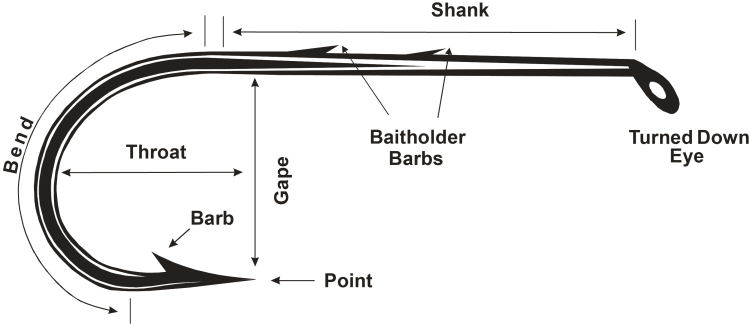
Before we get into the nitty-gritty of hook types, let’s cover the basic anatomy of a hook. Think of it like a fish skeleton – each part has a specific purpose:

Now that we’ve got the basics down let’s talk about hook points. Different points are designed for different types of fish and fishing techniques:
Best For: Saltwater fish with tough mouths, like tarpon or snook.
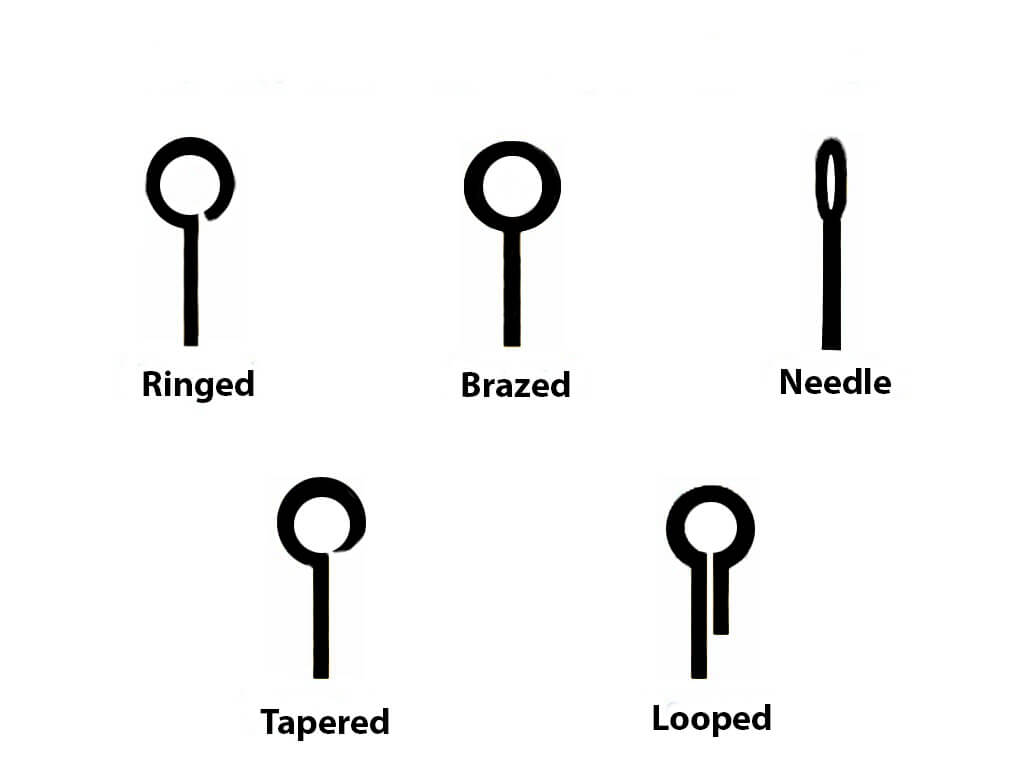
The hook eye might seem simple, but it plays a crucial role in how your bait or lure moves in the water. Here are the main types you’ll encounter:
Best For: Specific rigging techniques where the angle of the eye is important for bait movement.
Now that we’ve covered the basics of hook anatomy, let’s explore some of the most common hook types you’ll encounter in your fishing adventures.
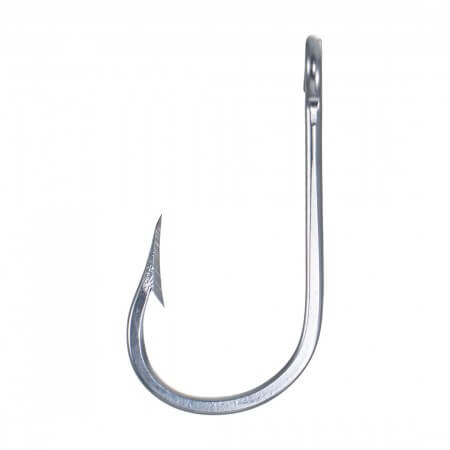
I remember using J-hooks exclusively when I first started fishing. I caught everything from bluegill to bass on them, and they were easy to tie and use. They’re still a staple in my tackle box to this day.
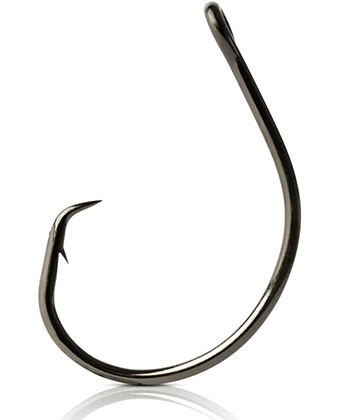
I’ll never forget the first time I used a circle hook for catfishing. I was skeptical at first, but when I saw how cleanly the hook set in the corner of the fish’s mouth, I was sold. It was a game-changer for me, and now I rarely use anything else for catfish.
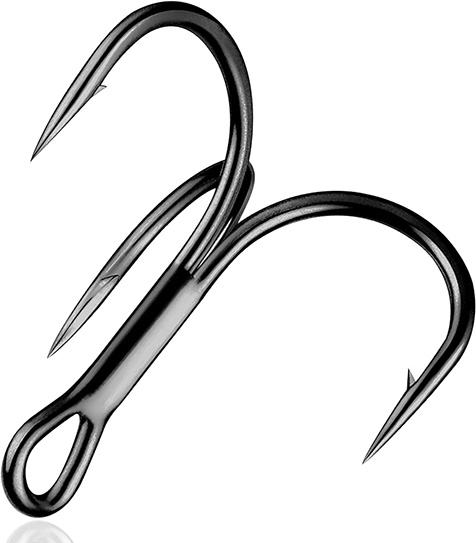
Treble hooks can be a bit intimidating for beginners, but once you get the hang of them, they can be incredibly effective. Just remember to be patient and let the fish fully take the bait before setting the hook.

I love using bait holder hooks when I’m fishing for panfish with worms. The barbs keep the worm securely on the hook, even with those tiny little nibbles you get from bluegill and crappie.
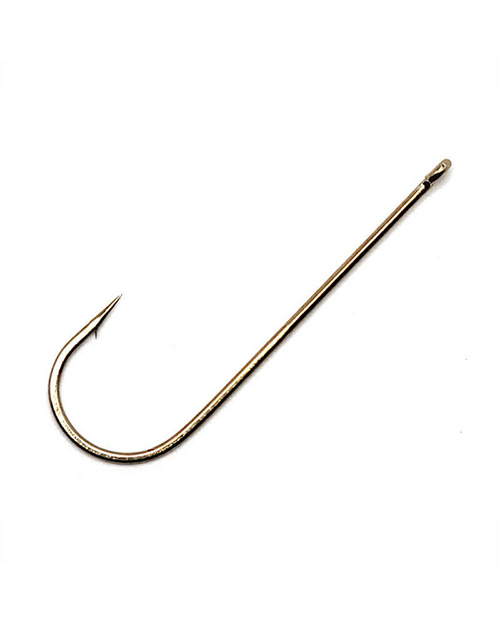
Aberdeen hooks are a favorite among trout anglers, and for good reason. Their thin wire and sharp points make them perfect for presenting small nymphs and other delicate baits to those finicky fish.
One of the most crucial aspects of hook selection is matching the hook to the fish you’re trying to catch. Different species have different mouth structures and feeding habits, so a hook that works great for bass might not be ideal for trout. Here’s a quick rundown of some common species and the hooks that work well for them:
Bass:
Bass are aggressive predators, so you want a hook that can handle their powerful strikes and runs.
J-hooks: A versatile option for live bait and a variety of lures.
Worm hooks: Specifically designed for fishing plastic worms and other soft plastics.
Offset hooks: Great for weedless presentations like the Texas rig.
Treble hooks: Often used on crankbaits, spinnerbaits, and other lures.
I once hooked a monster largemouth bass on a small J-hook meant for panfish. The fight was epic, but the hook eventually bent and straightened out, and I lost the fish. Lesson learned: Always choose a hook strong enough for the fish you’re targeting!
Trout:
Trout have delicate mouths, so you’ll want a smaller, thinner hook to avoid tearing their lips.
Aberdeen hooks: A favorite among trout anglers for their thin wire and sharp points.
Smaller J-hooks: Sizes 10-14 work well for most trout species.
I remember using an Aberdeen hook to catch a beautiful rainbow trout in a crystal-clear mountain stream. The fish barely felt the hook and fought like crazy, but the hook held strong, and I landed it safely.
Catfish:
Catfish have notoriously tough mouths, so you’ll need a hook that can penetrate their thick skin and hold on tight.
Circle hooks: A must-have for big catfish, especially when using live bait.
Kahle hooks: Similar to circle hooks but with a slightly different bend, also great for catfish.
Larger J-hooks: Sizes 1/0 and larger can be effective for smaller catfish.
I’ve had great success using circle hooks for catfish in rivers and lakes. They seem to hook themselves most of the time, and I’ve never had one bend or break, even on those monster flatheads.
Panfish:
Panfish like bluegill, crappie, and perch have smaller mouths, so smaller hooks are the way to go.
Aberdeen hooks: Their thin wire and sharp points are perfect for panfish.
Smaller J-hooks: Sizes 6-10 are a good starting point.
Bait holder hooks: Great for keeping small worms and other baits in place.
When I’m fishing for panfish, I often use a tiny Aberdeen hook with a single waxworm. It’s a simple presentation, but it’s incredibly effective for catching those feisty little guys.
Saltwater Fish:
Saltwater fishing opens up a whole new world of hook options, depending on the species you’re targeting.
Circle hooks: Essential for many saltwater species, including sharks, tarpon, and redfish.
J-hooks: Versatile and can be used for a variety of fish, from flounder to kingfish.
Specialized hooks: Different species often require specific hook types, such as flounder hooks, tuna hooks, or bonefish hooks.
I once had the opportunity to go deep-sea fishing for tuna, and the specialized circle hooks we used were massive compared to the hooks I was used to. But they were necessary for handling those powerful fish, and it was an experience I’ll never forget.
Choosing the Right Hook Size: It’s All About the Match
Hook size is just as important as hook type. Using the wrong size can mean missed strikes, lost fish, or even harming the fish you’re trying to catch. Here’s how to choose the right hook size:
Match the Bait: The hook should be proportionate to the size of your bait. You don’t want a tiny hook for a large bait or a giant hook for a small bait.
Consider the Fish: Smaller fish require smaller hooks, while larger fish need larger hooks.
Think About Your Line: Thicker lines can handle larger hooks, while lighter lines require smaller hooks.
Consult a Size Chart: There are plenty of hook size charts available online or at your local tackle shop. These charts can help you match the right hook size to your target species and bait

Whether to use a barbed or barbless hook is a personal choice with ethical considerations.
Barbed Hooks:
Pros: Barbed hooks are less likely to fall out of a fish’s mouth once they’re hooked.
Cons: They can cause more damage to the fish, especially if swallowed deeply.
Barbless Hooks:
Pros: Easier to remove from fish, causing less harm.
Cons: Can be more easily dislodged during the fight, leading to lost fish.
Personally, I prefer barbless hooks for most of my fishing. They make it easier and quicker to release fish unharmed, which is important for preserving fish populations. However, I do use barbed hooks in situations where a secure hookup is essential, like when fishing for toothy critters like pike or muskie.
When it comes to fishing hooks, quality should always be a priority. Cheap hooks may seem like a good deal, but they’re more likely to bend, break, or dull quickly. Invest in good quality hooks from reputable brands, and you’ll be rewarded with more successful fishing trips.
I learned this lesson the hard way after losing a trophy trout due to a cheap hook that bent under pressure. Since then, I’ve always opted for higher quality hooks, and I’ve never looked back.